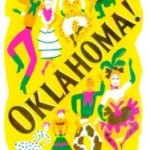 I called Show Boat the most influential American musical, but historian Thomas Hischak argues, “Not only is Oklahoma! the most important of the Rodgers and Hammerstein musicals, it is also the single most influential work in the American musical theater.” The fully integrated show made great strides in 1927 with Show Boat, but it firmly took root in 1943 with Oklahoma! — and began a Golden Age of American musical theater.
I called Show Boat the most influential American musical, but historian Thomas Hischak argues, “Not only is Oklahoma! the most important of the Rodgers and Hammerstein musicals, it is also the single most influential work in the American musical theater.” The fully integrated show made great strides in 1927 with Show Boat, but it firmly took root in 1943 with Oklahoma! — and began a Golden Age of American musical theater.
Building on the innovations he employed in Show Boat, Hammerstein went further in challenging the conventions about what a musical “should” look like, giving Oklahoma! a quiet opening (not a big production number) and a 15-minute “dream ballet” as its first act finale. Producer Mike Todd famously walked out during the show’s Boston tryout, saying, “No legs, no jokes, no chance.”
For their first collaboration, composer Richard Rodgers and librettist Oscar Hammerstein II adapted the 1931 Lynn Riggs play Green Grow the Lilacs, set in 1906 around Claremore, Indian Territory (later the state of Oklahoma). The musical tells the story of farm girl Laurey Williams and her two rival suitors, cowboy Curly McLain and farmhand Jud Fry. A subplot involves Laurey’s friend Ado Annie and cowboy Will Parker.
The Theatre Guild had produced the Riggs play. It wasn’t successful in 1931, but Guild producer Theresa Helburn saw a summer-stock version in 1941 that added folk songs and square dances, leading her to think the play could make a successful musical. She contacted Rodgers and his partner at the time, Lorenz Hart, whom the Guild had previously produced. Given Hart’s increasingly erratic nature, Rodgers asked Hammerstein to collaborate with them. Hart soon lost interest in the show and told Rodgers to continue on with Hammerstein.
The original Broadway production opened on March 31, 1943, directed by Rouben Mamoulian and choreographed by Agnes de Mille, starring Joan Roberts (Laurey), Alfred Drake (Curly), Howard Da Silva (Jud Fry), Celeste Holm (Ado Annie), and Lee Dixon (Will Parker). It ran for an unprecedented 2,212 performances (a record it held for a decade, until bested by My Fair Lady) and won a special Pulitzer Prize in 1944. New York Daily News critic Burns Mantle noted, “Oklahoma! really is different — beautifully different. … Oklahoma! seems to me to be the most thoroughly and attractively American musical comedy since Edna Ferber’s Show Boat.”
The 1955 film adaptation starred Shirley Jones (in her screen debut as Laurey), Gordon MacRae (Curly), Rod Steiger (Jud), Gloria Grahame (Annie), and Gene Nelson (Will), with direction by Fred Zinnemann (his only film musical) and a screenplay by Sonya Levien and William Ludwig. Rodgers and Hammerstein oversaw the film to prevent changes typically made in musical adaptations, such as interpolating outside songs.
Decca recorded most of the songs from the original stage production in 1943, creating the first Broadway cast album. It sold more than a million copies, so the label called the cast back into the studio to record three selections not originally included. In 2000, Decca released the full recording on CD.
For more about the making of Oklahoma!, read Max Wilk’s OK! The Story of Oklahoma!: A Celebration of America’s Most Beloved Musical (2002).
NEXT, listen to Annie Get Your Gun (1946) by Irving Berlin (music and lyrics) with Dorothy and Herbert Fields (book). After the success of Oklahoma!, Rodgers and Hammerstein began producing their shows and others. Dorothy Fields brought them the idea for this show, and they asked Jerome Kern to work with her on lyrics and her brother Herbert on book. A week after Kern began writing, he died, and R&H asked Irving Berlin to step in. It became the most successful of Berlin’s half dozen book shows. Perhaps a bit better than the original Broadway recording, Ethel Merman shines in the 1966 Lincoln Center production.
THEN, to get a taste of the work of that other R&H (Rodgers and Hart), listen to the 1950 studio cast recording of Pal Joey, the team’s best show. The original 1940 cast wasn’t preserved, so we don’t have Gene Kelly’s interpretation of the seminal musical antihero, but leading actress Vivienne Segal did return to recreate her performance.
Tomorrow, the PBS series Poetry in America will spotlight the work of Hammerstein protégé Stephen Sondheim with a discussion of the song “Finishing the Hat,” from his 1984 Pulitzer-winning Sunday in the Park with George. Taking part in the discussion are Sondheim veteran actors Raúl Esparza and Melissa Errico, who were Georges and Dot in the Kennedy Center production. Click here to watch a preview.
